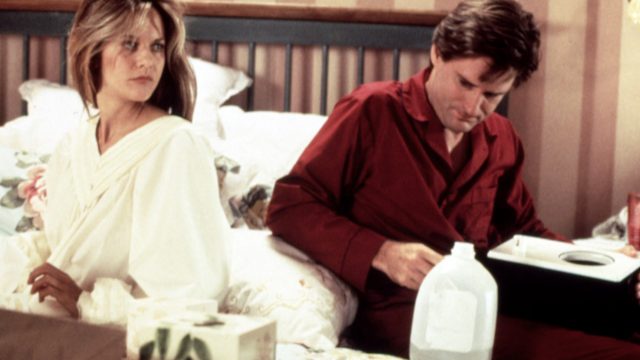It’s a delicate balance to strike. He’s got to be a nice guy, because the audience has to have faith in the heroine’s taste. On the other hand, he’s got to be obviously wrong for her, because we have to want her to end up with someone else. He’s got to be decent-looking, but he can’t be too handsome. He should be devoted to the heroine, because we have to know she’s worthy of that, but he’s got to back off when she walks away so as not to complicate her new relationship. He is the guy the heroine starts a romantic comedy with.
It’s awkward. That’s probably why some romantic comedies forgo the character. However, when they do, it’s usually to tell us that something is wrong with Our Heroine. After all, why else would she be single? So she’s in a relationship with a guy who is almost but not quite right, and we the audience know they’re going to break up somewhere along the way. What else would be the point? And after all, Tom Hanks or Richard Gere or someone is standing right there!
For me, the ultimate example of this character is Walter, so ably played by Bill Pullman in Sleepless in Seattle. His worst failing is that he’s boring, but he’s boring in a pleasant sort of way. I feel as though Meg Ryan’s Annie could live the rest of her life with Walter and never fully understand why she feels a constant but low-level sense of discontent. There’s nothing wrong with him, but that’s half the problem. There’s nothing to explore with Walter, because everything is there right in front of you. For a bad relationship, the movie presents us with Rosie O’Donnell’s Becky, whose never-seen boyfriend is clearly a disaster. Walter is boring and allergic to everything and predictable, and I at least always end the movie hoping he meets a perfectly nice woman with no sense of adventure and a lot of patience with food requirements.
Every once in a while, it even seems as though the relationship that has to end to move the plot along is healthier, because of course so much of the romantic comedy genre tends to rely on actions that make no sense in reality. Annie, after all, is fairly normal, and she goes so far as to hire a private detective to check out a man she’s never met. Stalking is pretty well par for the course in romantic comedies, and at least the doomed relationship at the beginning doesn’t tend to inspire anyone to major crimes.
Men are allowed to be trapped in their relationships, if it is the man who is in one at the beginning. Typical here is Madeline Kahn as Eunice Burns in What’s Up, Doc? She is domineering and shrewish, and it’s clear from the start that escaping from her is its own reward, even if you don’t actually think Howard Bannister (Ryan O’Neal) and Judy Maxwell (Barbra Streisand) are terribly well suited to one another. Which I don’t. I figure Howard and Judy will break up, but at least I don’t picture the murder trial.
But with women, I think the whole point is that we have to be aware that she’s capable of a relationship with someone other than Our Hero. This goes back at least as far as The Philadelphia Story, where Tracy (Katharine Hepburn) has not two but three choices, one of whom is acceptable but played by someone I have to look up (John Howard) and therefore obviously not the person with whom she’ll end the picture. Now, she’s another person I think would be better off just being single at the end, but still. She’s marrying someone acceptable to convince us that the problems aren’t with her but with the situation.
We also have to see that Our Heroine has overcome whatever the stumbling block is to her being perfectly ready to marry Our Hero. We have to see the broken relationship she can move away from to end up in the fairy tale one. But if the relationship is too broken, we might start to think about whether she’s really overcome her problems at all. So some normal, boring guy gets sacrificed on the altar of Movie Happiness, because the character says more about the expectations of the audience than the heroine of the movie. Or at least the expectations of the people making the movie.

